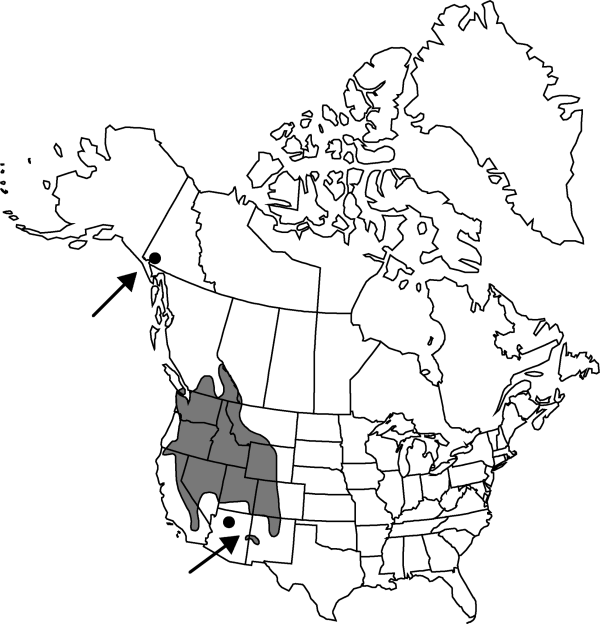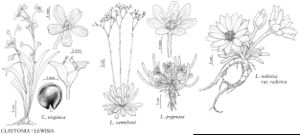Difference between revisions of "Lewisia pygmaea"
in A. Gray et al., Syn. Fl. N. Amer. 1: 268. 1897.
FNA>Volume Importer |
imported>Volume Importer |
||
| (6 intermediate revisions by 2 users not shown) | |||
| Line 1: | Line 1: | ||
{{Treatment/ID | {{Treatment/ID | ||
|accepted_name=Lewisia pygmaea | |accepted_name=Lewisia pygmaea | ||
| − | |accepted_authority=(A. Gray) B. L. Robinson | + | |accepted_authority=(A. Gray) B. L. Robinson |
|publications={{Treatment/Publication | |publications={{Treatment/Publication | ||
|title=in A. Gray et al., Syn. Fl. N. Amer. | |title=in A. Gray et al., Syn. Fl. N. Amer. | ||
| Line 7: | Line 7: | ||
|year=1897 | |year=1897 | ||
}} | }} | ||
| − | |basionyms={{Treatment/ID/ | + | |special_status={{Treatment/ID/Special_status |
| + | |code=F | ||
| + | |label=Illustrated | ||
| + | }}{{Treatment/ID/Special_status | ||
| + | |code=E | ||
| + | |label=Endemic | ||
| + | }} | ||
| + | |basionyms={{Treatment/ID/Basionym | ||
|name=Talinum pygmaeum | |name=Talinum pygmaeum | ||
|authority=A. Gray | |authority=A. Gray | ||
| − | }}{{Treatment/ID/ | + | |rank=species |
| + | |publication_title=Amer. J. Sci. Arts, ser. | ||
| + | |publication_place=2, 33: 407. 1862 (as pygnaeum) | ||
| + | }} {{Treatment/ID/Basionym | ||
|name=Calandrinia pygmaea | |name=Calandrinia pygmaea | ||
|authority=(A. Gray)A. Gray 1873 | |authority=(A. Gray)A. Gray 1873 | ||
| + | |rank=species | ||
| + | |publication_title= | ||
| + | |publication_place= | ||
}} | }} | ||
|synonyms={{Treatment/ID/Synonym | |synonyms={{Treatment/ID/Synonym | ||
|name=Calandrinia grayi | |name=Calandrinia grayi | ||
|authority=Britton | |authority=Britton | ||
| − | }}{{Treatment/ID/Synonym | + | |rank=species |
| + | }} {{Treatment/ID/Synonym | ||
|name=Lewisia exarticulata | |name=Lewisia exarticulata | ||
|authority=H. St. John | |authority=H. St. John | ||
| − | }}{{Treatment/ID/Synonym | + | |rank=species |
| + | }} {{Treatment/ID/Synonym | ||
|name=Lewisia glandulosa | |name=Lewisia glandulosa | ||
|authority=(Rydberg) Clay | |authority=(Rydberg) Clay | ||
| − | }}{{Treatment/ID/Synonym | + | |rank=species |
| + | }} {{Treatment/ID/Synonym | ||
|name=Lewisia minima | |name=Lewisia minima | ||
|authority=(A. Nelson) A. Nelson | |authority=(A. Nelson) A. Nelson | ||
| − | }}{{Treatment/ID/Synonym | + | |rank=species |
| + | }} {{Treatment/ID/Synonym | ||
|name=Lewisia pygmaea var. aridorum | |name=Lewisia pygmaea var. aridorum | ||
|authority=Bartlett | |authority=Bartlett | ||
| − | }}{{Treatment/ID/Synonym | + | |rank=variety |
| + | }} {{Treatment/ID/Synonym | ||
|name=Lewisia pygmaea subsp. glandulosa | |name=Lewisia pygmaea subsp. glandulosa | ||
|authority=(Rydberg) Ferris | |authority=(Rydberg) Ferris | ||
| − | }}{{Treatment/ID/Synonym | + | |rank=subspecies |
| + | }} {{Treatment/ID/Synonym | ||
|name=Lewisia sierrae | |name=Lewisia sierrae | ||
|authority=(H. St. John) Rydberg | |authority=(H. St. John) Rydberg | ||
| − | }}{{Treatment/ID/Synonym | + | |rank=species |
| + | }} {{Treatment/ID/Synonym | ||
|name=Oreobroma aridorum | |name=Oreobroma aridorum | ||
|authority=Rydberg | |authority=Rydberg | ||
| − | }}{{Treatment/ID/Synonym | + | |rank=species |
| + | }} {{Treatment/ID/Synonym | ||
|name=Oreobroma exarticulatum | |name=Oreobroma exarticulatum | ||
|authority=(Britton) Rydberg | |authority=(Britton) Rydberg | ||
| − | }}{{Treatment/ID/Synonym | + | |rank=species |
| + | }} {{Treatment/ID/Synonym | ||
|name=Oreobroma glandulosum | |name=Oreobroma glandulosum | ||
|authority=A. Nelson | |authority=A. Nelson | ||
| − | }}{{Treatment/ID/Synonym | + | |rank=species |
| + | }} {{Treatment/ID/Synonym | ||
|name=Oreobroma grayi | |name=Oreobroma grayi | ||
|authority=(A. Gray) Howell | |authority=(A. Gray) Howell | ||
| − | }}{{Treatment/ID/Synonym | + | |rank=species |
| + | }} {{Treatment/ID/Synonym | ||
|name=Oreobroma minimum | |name=Oreobroma minimum | ||
| − | |authority= | + | |authority= |
| − | }}{{Treatment/ID/Synonym | + | |rank=species |
| + | }} {{Treatment/ID/Synonym | ||
|name=Oreobroma pygmaeum | |name=Oreobroma pygmaeum | ||
| − | |authority= | + | |authority= |
| + | |rank=species | ||
}} | }} | ||
|hierarchy=Portulacaceae;Lewisia;Lewisia pygmaea | |hierarchy=Portulacaceae;Lewisia;Lewisia pygmaea | ||
| Line 68: | Line 94: | ||
|elevation=2300-4200 m | |elevation=2300-4200 m | ||
|distribution=Alta.;B.C.;Yukon;Ariz.;Calif.;Colo.;Idaho;Mont.;Nev.;N.Mex.;Oreg.;Utah;Wash.;Wyo. | |distribution=Alta.;B.C.;Yukon;Ariz.;Calif.;Colo.;Idaho;Mont.;Nev.;N.Mex.;Oreg.;Utah;Wash.;Wyo. | ||
| − | |discussion=<p>The circumscription and diagnosis of Lewisia pygmaea is problematic because of morphologic variability, intermediacy, and/or hybridization with L. nevadensis (see L. T. Dempster 1990). In the range of typical forms of L. nevadensis (see discussion under 11. L. nevadensis), one or more forms of L. pygmaea will also occur, but at higher elevations. Segregates of L. pygmaea recognized elsewhere as species include L. glandulosa, which occurs in rocky substrates above 3000 m in the central and southern Sierra Nevada and is characterized by elongate, sinuous taproots (L. T. Dempster 1990); and L. sierrae, which occurs in moist flats above 2400 m in the central Sierra Nevada and includes diminutive plants with irregularly eglandular-toothed (occasionally entire) sepals (B. Mathew 1989b). Dempster postulated that the variable and widely distributed L. pygmaea represents a hybrid species derived from L. nevadensis and L. glandulosa.</p> | + | |discussion=<p>The circumscription and diagnosis of <i>Lewisia pygmaea</i> is problematic because of morphologic variability, intermediacy, and/or hybridization with <i>L. nevadensis</i> (see L. T. Dempster 1990). In the range of typical forms of <i>L. nevadensis</i> (see discussion under 11. <i>L. nevadensis</i>), one or more forms of <i>L. pygmaea</i> will also occur, but at higher elevations. Segregates of <i>L. pygmaea</i> recognized elsewhere as species include <i>L. glandulosa</i>, which occurs in rocky substrates above 3000 m in the central and southern Sierra <i>Nevada</i> and is characterized by elongate, sinuous taproots (L. T. Dempster 1990); and L. sierrae, which occurs in moist flats above 2400 m in the central Sierra <i>Nevada</i> and includes diminutive plants with irregularly eglandular-toothed (occasionally entire) sepals (B. Mathew 1989b). Dempster postulated that the variable and widely distributed <i>L. pygmaea</i> represents a hybrid species derived from <i>L. nevadensis</i> and <i>L. glandulosa</i>.</p> |
|tables= | |tables= | ||
|references= | |references= | ||
| Line 77: | Line 103: | ||
-->{{#Taxon: | -->{{#Taxon: | ||
name=Lewisia pygmaea | name=Lewisia pygmaea | ||
| − | + | |authority=(A. Gray) B. L. Robinson | |
| − | |authority=(A. Gray) B. L. Robinson | ||
|rank=species | |rank=species | ||
|parent rank=genus | |parent rank=genus | ||
| Line 91: | Line 116: | ||
|publication title=in A. Gray et al., Syn. Fl. N. Amer. | |publication title=in A. Gray et al., Syn. Fl. N. Amer. | ||
|publication year=1897 | |publication year=1897 | ||
| − | |special status= | + | |special status=Illustrated;Endemic |
| − | |source xml=https:// | + | |source xml=https://bitbucket.org/aafc-mbb/fna-data-curation/src/2e0870ddd59836b60bcf96646a41e87ea5a5943a/coarse_grained_fna_xml/V4/V4_978.xml |
|genus=Lewisia | |genus=Lewisia | ||
|species=Lewisia pygmaea | |species=Lewisia pygmaea | ||
Latest revision as of 22:02, 5 November 2020
Taproots gradually ramified distally or shortly fusiform, rarely subnapiform. Stems ± prostrate or suberect, becoming reflexed in fruit, 1–6 cm. Leaves: basal leaves withering at or soon after anthesis, ± sessile or gradually tapered to long petiole, blade linear to linear-oblanceolate, ± flattened, 3–9 cm, margins entire, apex acute to obtuse; cauline leaves absent. Inflorescences 2–4(–7)-flowered in racemose cymes or with flowers borne singly; bracts 2, opposite, plus 1 subtending each successive flower if more than 1 flower, linear-oblong, linear-lanceolate, or lanceolate, (2–)4–10 mm, margins glandular-toothed, sometimes eglandular-toothed, apex acute. Flowers pedicellate, not disarticulate in fruit, 1.5–2 cm diam.; sepals 2, suborbiculate, broadly ovate, or obovate, 2–6 mm, herbaceous at anthesis, margins usually glandular-toothed, sometimes eglandular-toothed or rarely ± entire, apex usually truncate, sometimes rounded, obtuse, subacute, or apiculate; petals 5–9, white, pink, or magenta, sometimes green at base, narrowly oblong, elliptic, or oblanceolate, 4–10 mm; stamens (4–)5–8; stigmas 3–6; pedicel 2–5(–10) mm. Capsules 4–5 mm. Seeds 15–24, 1–2 mm, shiny, smooth. 2n = ca. 66.
Phenology: Flowering late spring–late summer.
Habitat: Open places in short turf or gravelly or rocky substrates
Elevation: 2300-4200 m
Distribution

Alta., B.C., Yukon, Ariz., Calif., Colo., Idaho, Mont., Nev., N.Mex., Oreg., Utah, Wash., Wyo.
Discussion
The circumscription and diagnosis of Lewisia pygmaea is problematic because of morphologic variability, intermediacy, and/or hybridization with L. nevadensis (see L. T. Dempster 1990). In the range of typical forms of L. nevadensis (see discussion under 11. L. nevadensis), one or more forms of L. pygmaea will also occur, but at higher elevations. Segregates of L. pygmaea recognized elsewhere as species include L. glandulosa, which occurs in rocky substrates above 3000 m in the central and southern Sierra Nevada and is characterized by elongate, sinuous taproots (L. T. Dempster 1990); and L. sierrae, which occurs in moist flats above 2400 m in the central Sierra Nevada and includes diminutive plants with irregularly eglandular-toothed (occasionally entire) sepals (B. Mathew 1989b). Dempster postulated that the variable and widely distributed L. pygmaea represents a hybrid species derived from L. nevadensis and L. glandulosa.
Selected References
None.
